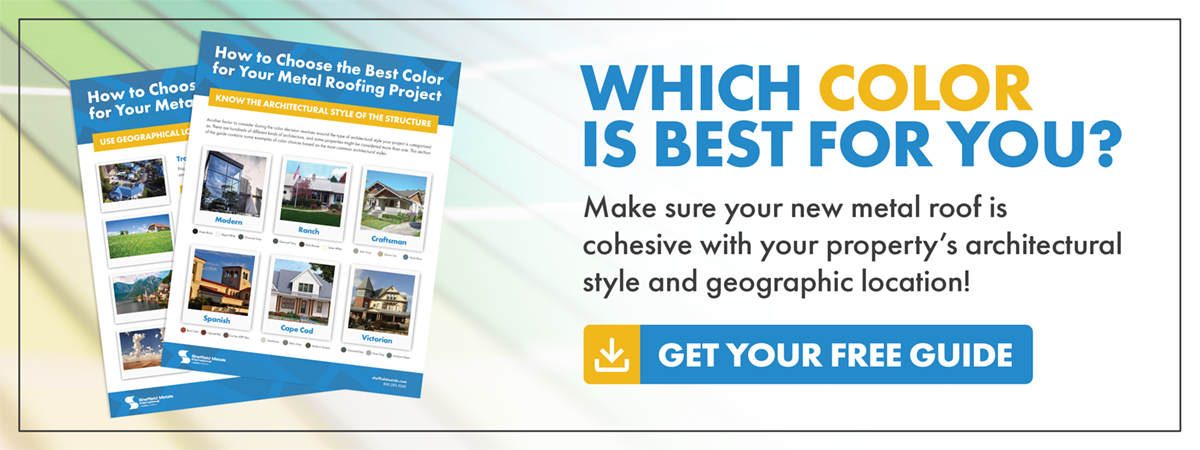For a property owner, often the most challenging decision tends to be what color to choose for the home or building they’re putting a metal roof or wall on.
It doesn’t help that metal can come in practically any color, as most coil and sheet manufacturers offer custom colors as options.
So, what color should you put on your property? Well, it depends. There are many different factors to keep in mind during your decision process.
At Sheffield Metals, we’ve spent over 20 years supplying the painted and bare metal sheets and coils that have been installed on thousands of structures as roof and wall panels, as well as trims. We’ve learned that picking the right color is one of the most difficult parts of the pre-installation process.
To help you out, we’ll discuss the following topics in this article:
- Factors that can help you choose the right metal roof or wall color
- Different types of paint and coatings available
- Popular colors selected by Sheffield Metals customers
- Steps that will help you narrow down color choices

Factors to Help You Choose the Best Metal Roof Color
Some property owners might know what color they want before the project ever starts. However, not everyone might know what will look best on their home or building. Here’s a comprehensive list of factors to keep in mind that can help you narrow down your color selections.
Base Color Choice on Your Personal Preference
Every building is unique, and every property owner possesses different tastes as far as colors go. That’s why one of the best parts about owning the structure a new metal roof is going on is that you get to decide what color YOU like. We could go on and on about colors that complement each other, but at the end of the day, the color you choose should be one that you enjoy looking at.
Complementary Colors On or Near the Structure
More factors that can help you with the color decision are the current colors on your property. You’re likely going to want to have a roof color that you think looks good when placed next to or nearby the other exterior elements of the property. Look closer and note what color the following items are:
- Siding or the color of the exterior walls
- Exterior trim
- Gutters and downspouts
- Door frame(s)
- Door(s)
- Window frame(s)
- Fascia board
- Column(s)
- Railing(s)
- Signs
- Nearby sheds and barns
- Landscaping features
- Neighborhood trends (For instance, if everyone has a Colonial Red or Terra Cotta-colored roof, you probably wouldn’t want to have the Regal Blue roof in the neighborhood.)
Once you know the other colors you need to complement your metal roof selection, you’ll be more equipped to decide what works for your property. Or, if you’re building or remodeling more than just the roof, you also have the opportunity to pick colors for the above-mentioned exterior elements if you are set on a specific metal roof color.
Additionally, while it is entirely a personal preference, most property owners don’t want their property’s roof to stick out too much from others in the same residential or commercial neighborhood. Take a look at other color schemes that are common near your home or building, which can help further guide you to the best metal roof color.
Use Geographic Location to Guide Your Decision
Where you live, or where your building is located, can play a part in what color you choose. For example:
- Tropical – Building and homeowners in tropical locations tend to install metal roofs in colors that are brighter and livelier than in non-tropical regions. Favored colors in the tropics include Aged Copper, Patina Green, Slate Blue, Terra Cotta, and custom colors.
- Mountains and forests – Most buildings settled in the mountains or forested areas utilize more of the earth tones that match the surroundings. Popular colors for these areas are Hartford Green, Evergreen, Dark or Medium Bronze, and all of the gray finishes.
- Plains – Similar to mountainous areas, colors used on exterior buildings in the Plains tend to be softer earth tones, including Ash Gray, Dove Gray, Surrey Beige, and Mansard Brown.
- South – States or regions in the southern United States tend to follow warmer color schemes and are heavily influenced by Latin architecture; for roofing specifically, Spanish tile is prominent. For properties that want the look of Spanish tile and the protection/longevity of metal roofing, standard colors include Terra Cotta and Colonial Red.
Know the Architectural Style of the Structure
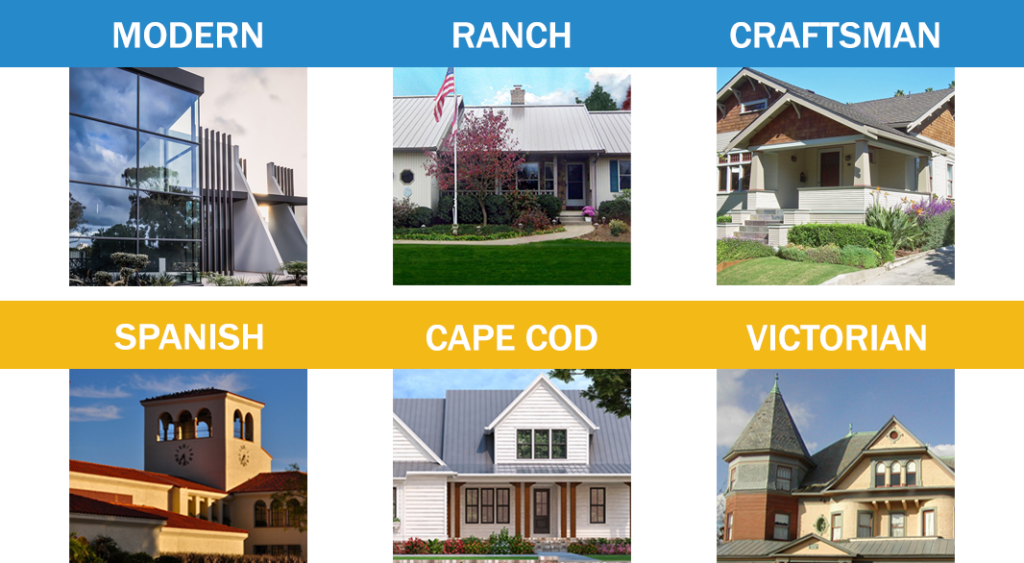
Another factor to consider during the color decision revolves around the type of architectural style your home or property is categorized as. There are hundreds of different kinds of architecture, and some properties might be considered more than one, but here are some examples of color choices based on architectural style:
- Building style: Modern
- Color options: Matte Black, Regal White, Charcoal Gray
- Building style: Ranch
- Color options: Charcoal Gray, Dark Bronze, Solar White
- Building style: Craftsman
- Color options: Ash Gray, Sierra Tan, Slate Blue
- Building style: Spanish
- Color options: Terra Cotta, Colonial Red, COR-TEN AZP® RAW
- Building style: Cape Cod
- Color options: Sandstone, Slate Gray, Medium Bronze
- Building style: Victorian
- Color options: Charcoal Gray, Dove Gray, Hemlock Green
- Building Style: Farmhouse and Barns
- Color options: Regal Red, Colonial Red, White
Emissivity and Solar Reflectance Index (SRI)
One huge draw to metal roofing is the option to install cool metal roofing, which are highly emissive metal sheets and coils with reflective coatings that have a higher Solar Reflectance Index (SRI) than other roofing materials. For a little background on what emissivity and SRI refer to:
- Emissivity – How quickly the surface (or metal in this case) releases its absorbed heat and returns to its average temperature.
- SRI – How reflective of the sun’s rays a surface is (cool metal roofing has a higher SRI), which allows the panels to absorb less heat from the sun’s rays. SRI is determined on a scale from 0 to 100:
- Materials that absorb and retain solar radiation (which become hotter in the sun) have a lower SRI number. These tend to be darker colors, including black and dark browns.
- Highly reflective materials (which remain cooler in the sun) have a higher SRI number. These tend to be lighter colors, such as white or light gray.
If a structure needs to adhere to specific SRI ENERGY STAR® or LEED 2013 requirements, color choices could be limited. Should you have questions about the color limitations and how to determine the correct SRI value based on your roof’s slope, contact the manufacturer and they can help you, your architect, or your contractor.
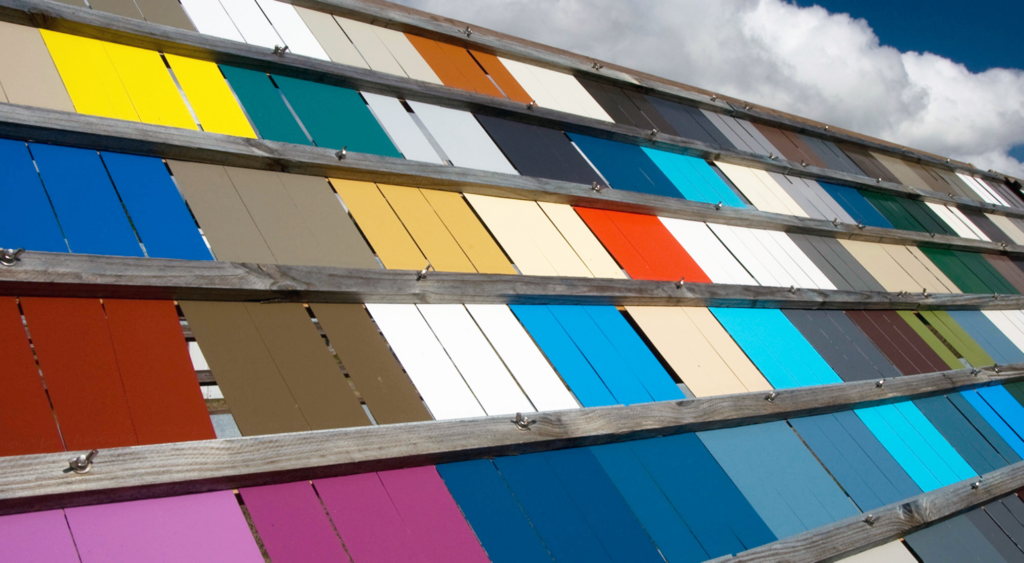
Adhere to Home Owners Association (HOA)
If your house is part of a Home Owners Association (HOA) or your structure is in a historic downtown district, there might be some color restrictions that you should be aware of. In fact, some HOAs don’t allow metal roofs to be installed at all, which is why it’s essential to check with your municipality before you put down any money on a metal roof in a specific color.
For reference, here are some common reasons HOAs cite as reasons to deny the installation of metal roofing or specific colors:
- Metal is often thought of as looking “industrial.”
- Metal might be inconsistent or go against the look or aesthetics of a neighborhood.
- Some municipalities don’t want roof paint finishes to have a high glare.
- Specular gloss – Defined as “an optical property which indicates how well a surface reflects light in a specular (mirror-like) direction.”
Additionally, historic properties or buildings in landmark districts might be limited to specific material and color options.
Metal Panel or Trim Paint Coating Categories & Types
The combination possibilities for color and paint types are endless, but we wanted to give you an idea of the different paint resin types and finishes that you can choose from.
Polyvinylidene Fluoride (PVDF) Coated Galvalume® & Aluminum
This resin is made up of about 70% PVDF and 30% acrylic blend. Commonly referred to as Kynar 500® or Hylar 5000®, PVDF resins are the best protective coatings available to withstand extreme temperatures, sun exposure, humidity, and pollution particles in the atmosphere. PVDF-coated metal is easily the most popular metal roofing option available today.
Our standard PVDF products include:
- Standard
- Premium
- Metallic
- Weathered
Silicone-Modified Polyester (SMP) Coated Galvalume® & Aluminum
SMP coatings, which are called WeatherXL™ at Sherwin-Williams, are a step below PVDF in terms of quality and longevity. However, SMPs have been known to be a great option to defend against extreme weather conditions.
Specialty Colors
Beyond coated and bare Galvalume and aluminum, there are other colors as specialty sheet and coil, including:
- Copper
- Stainless steel
10 Popular Metal Roof and Wall Colors & Finishes at Sheffield Metals
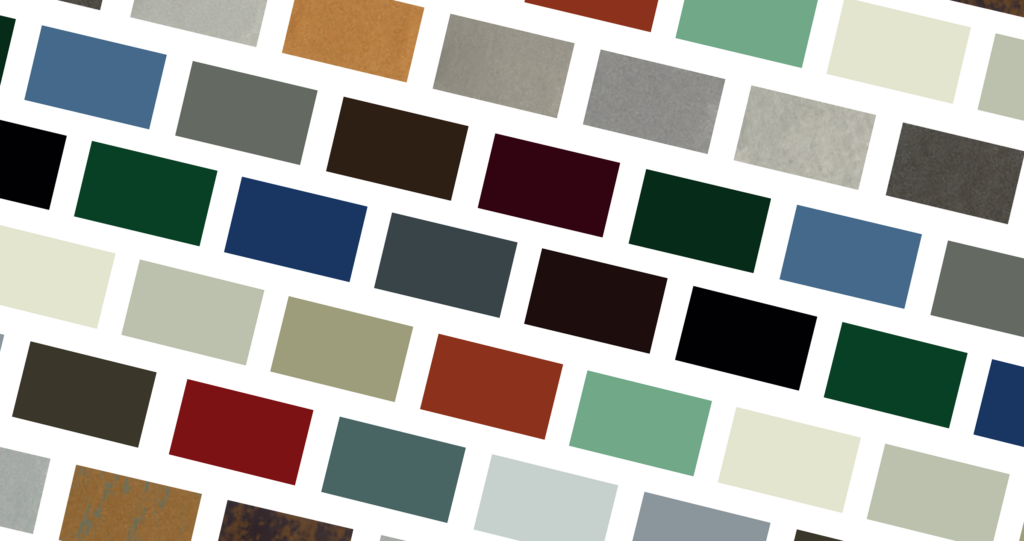
The popularity of colors tends to fluctuate, but several colors are typically at or near the top of the bestsellers list. Here’s a collection of Sheffield Metals’ most popular metal roof, wall, and trim colors, which are provided by Sherwin-Williams:
- Matte Black
- Dark Bronze
- Galvalume Plus (acrylic-coated Galvalume)
- Charcoal Gray
- Medium Bronze
- Slate Gray
- Regal White
- Mansard Brown
- Evergreen
- Copper Metallic
Steps to Take for Choosing the Best Metal Roof Color
Step #1: Explore Color Palettes & Photo Galleries
Exploring different exterior color palettes online is easily one of the best first steps you can take when choosing a color for your roof. Sherwin Williams, one of the biggest names in paint and metal coil coatings, offers home and building owners a variety of resources, including exterior color palettes based on architectural style.
Beyond palettes, look up some manufacturers’ photo galleries to gather some inspiration. You might see a color that you’ve never considered before that might look great on your building.
Step #2: Look at Color Choices From Manufacturers
Once you have an idea of the color palette that you like or believe would work well with your building, it’s time to take a look at colors offered by different manufacturers.
This is the point where you should have a conversation with the contractor or architect about the manufacturers available to you or if there are any restrictions. They can give you a good idea of what suppliers they like to use, discuss popular color options, and provide suggestions on what color(s) they might recommend. However, if you’re the property owner, remember that it is your ultimate decision.
Reputable manufacturers should have their colors listed on their website, which may also be available as a downloadable color card. Most suppliers tend to have similar standard colors, especially if they use one of the prominent paint suppliers such as Sherwin-Williams (Valspar) or PPG. If you want a color that is more vibrant, unique, or specific to a branding style, there’s also the option for custom colors.
If you’re looking at colors but are struggling to envision what it would look like on your actual structure, step #3 can help ease some of that stress.
Step #3: Use a Roof Visualizer to Upload a Photo of Your Structure
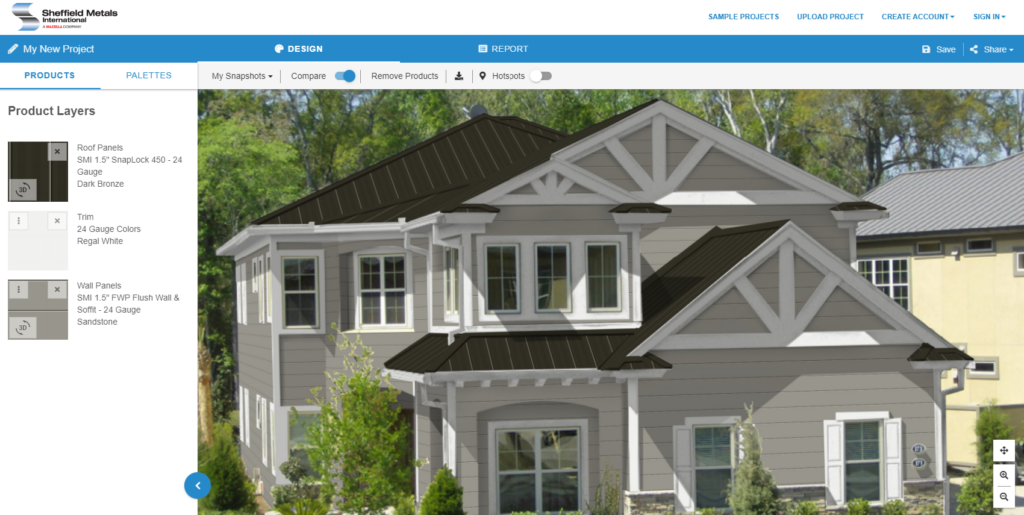
The ability to see different colors on a structure makes a difference, especially if you’re deciding between two or more colors. Roof visualizers are designed to help.
In fact, Sheffield Metals has an interactive Color Visualizer tool where you can upload a photo of your building, whether it’s residential, commercial, architectural, agricultural, etc., and see what each of our colors would look like on your roof, wall, and trim. Or, if you don’t want to take a picture of your structure, there are also standard building photos available to choose from if you just want a better idea of how colors differ when seen on a physical property.
Best of all: Sheffield Metals’ Color Visualizer is 100% free of charge.
Step #4: Request Metal Color Chips from the Manufacturer
While the Color Visualizer is an excellent tool for some, we understand that not everyone wants to rely on a digital mockup of their future roof or wall system. That’s why you can request color samples (cutouts of the painted metal sheet/coil) that’ll be shipped directly to you to provide the most realistic representation of the color you can expect.
Once you receive the colors you wanted samples of, you can go out to the property and compare the colors with the other elements of the building and environment. That way, you have a better visual of the final product and can feel the most confident in picking the best color for you.
Step #5: Discuss with the Contractor/Architect & Make the Final Decision
When you’re towards the end of making your color choice, it’s time to have another discussion with the contractor or architect. You should tell them the color you’ve chosen and then they should take the necessary steps to order or specify your selection.
Final Thoughts on Choosing the Best Metal Roof Color
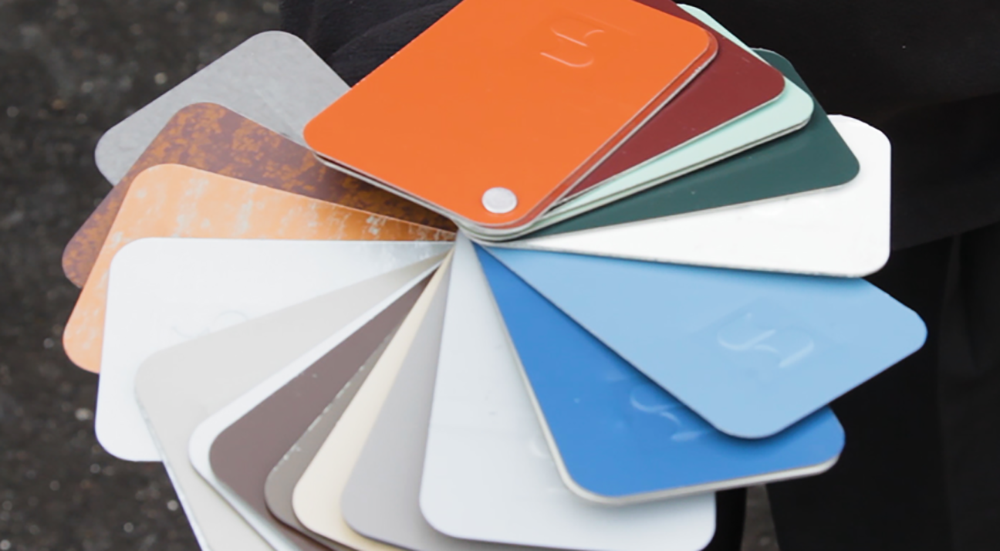
It might seem stressful to choose the right color for your metal roof or wall project. However, if you do your due diligence and use the resources made available by manufacturers and designers, your decision will be easier and you’ll be happier with the end result.
To recap, remember:
- Exterior colors will differ for every property based on geographic location, architectural style, environment, temperature, surrounding elements, and local organizations.
- There are various types of colors and textures available as metal roofing, including custom colors that can be matched by paint suppliers.
- Use a manufacturer’s roof visualizer tool to see how a specific color will look on a property, or request physical color samples for the most authentic representation.
- If you’re having difficulty deciding, contact the metal sheet/coil manufacturer. They often have experienced design personnel who can help with projects.
At Sheffield Metals, we’re always listening to customer feedback about how we can better help with their projects. One prominent idea was that we needed an updated visualizer tool to help customers choose colors for their roof and wall projects. We listened, and that’s why we now have a new and improved Sheffield Metals Color Visualizer available on our website!
For more questions about colors, project designs or how to use our visualizer tool, please contact our architectural department today!
